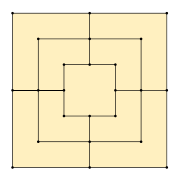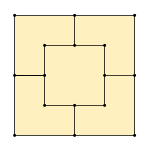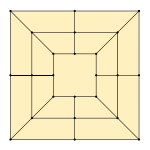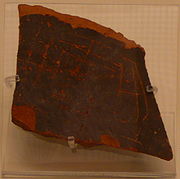
Nine Men's Morris
Encyclopedia
Nine Men's Morris is an abstract strategy
board game for two players that emerged from the Roman Empire
. The game is also known as Nine Man Morris, Mill, Mills, Merels, Merelles, and Merrills in English.
Three Men's Morris, Six Men's Morris and Twelve Men's Morris are variants of Nine Men's Morris; see below.
, no legal moves.
 The game begins with an empty board. Players take turns placing their pieces on empty spots. If a player is able to form a straight row of three pieces along one of the board's lines (i.e. not diagonally), he has a "mill" and may remove one of his opponent's pieces from the board; removed pieces may not be placed again. Players must remove any other pieces first before removing a piece from a formed mill. Once all eighteen pieces have been used, players take turns moving.
The game begins with an empty board. Players take turns placing their pieces on empty spots. If a player is able to form a straight row of three pieces along one of the board's lines (i.e. not diagonally), he has a "mill" and may remove one of his opponent's pieces from the board; removed pieces may not be placed again. Players must remove any other pieces first before removing a piece from a formed mill. Once all eighteen pieces have been used, players take turns moving.
As in the placement stage, a player who aligns three of his pieces on a board line has a mill and may remove one of his opponent's pieces, avoiding the removal of pieces in mills if at all possible.
Any player reduced to two pieces is unable to remove any more opposing pieces and thus loses the game.
An ideal position, which typically results in a win, is to be able to shuttle one piece back and forth between two mills, removing a piece every turn. For example, in the diagram above, white can win the game even if black moves first.
| ||
||
|Six Men's Morris gives each player six pieces and is played without the outer square found on the board of Nine Men's Morris. Flying is not allowed. It was popular in Italy, France and England during the Middle Ages but was obsolete by 1600. This board is also used for Five Men's Morris. Seven Men's Morris uses this board with a cross in the center.
|}

Twelve Men's Morris adds four diagonal lines to the board and gives each player twelve pieces. This means the board can be filled in the placement stage; if this happens the game is a draw. This variation on the game is popular amongst rural youth in South Africa where it is known as Morabaraba
and is now recognized as a sport in that country. The same board is also used for Eleven Men's Morris.
 According to R. C. Bell, the earliest known board for the game includes diagonal lines and was "cut into the roofing slabs of the temple at Kurna
According to R. C. Bell, the earliest known board for the game includes diagonal lines and was "cut into the roofing slabs of the temple at Kurna
in Egypt" c. 1400 BCE. However, Friedrich Berger writes that some of the diagrams at Kurna include Coptic
crosses, making it "doubtful" that the diagrams date to 1400 BCE. Berger concludes, "certainly they cannot be dated."
One of the earliest mentions of the game may be in Ovid
's Ars Amatoria
. In book III (c. 8 CE), after discussing Latrones
, a popular board game, Ovid wrote:
Berger believes the game was "probably well known by the Romans", as there are many boards on Roman buildings, even though dating them is impossible because the buildings "have been easily accessible" since they were built. It is possible that the Romans were introduced to the game via trade routes, but this cannot be proven.
 The game peaked in popularity in medieval England. Boards have been found carved into the cloister
The game peaked in popularity in medieval England. Boards have been found carved into the cloister
seats at the English
cathedral
s at Canterbury
, Gloucester
, Norwich, Salisbury and Westminster Abbey
. These boards used holes, not lines, to represent the nine spaces on the board — hence the name "nine holes" — and forming a diagonal row did not win the game. Another board is carved into the base of a pillar in Chester Cathedral
in Chester
.
In Shakespeare
's 16th century work A Midsummer Night's Dream
, Titania laments that it is no longer played: "The nine men's morris is filled up with mud" (A Midsummer Night's Dream, Act II, Scene I).
Some authors say the game's origin is uncertain. It has been speculated that its name may be related to Morris dance
s, and hence to Moorish, but according to Daniel King, "the word 'morris' has nothing to do with the old English dance of the same name. It comes from the Latin word merellus, which means a counter or gaming piece." King also notes that the game was popular among Roman soldiers.
In some European countries, the design of the board was given special significance as a symbol of protection from evil, and "to the ancient Celts, the Morris Square was sacred: at the center lay the holy Mill or Cauldron, a symbol of regeneration; and emanating out from it, the four cardinal directions, the four elements and the four winds."
Abstract strategy game
An abstract strategy game is a strategy game, aiming to minimise luck, and without a theme. Almost all abstract strategy games will conform to the strictest definition of: a board or card game, in which there is no hidden information, no non-deterministic elements , in which two players or teams...
board game for two players that emerged from the Roman Empire
Roman Empire
The Roman Empire was the post-Republican period of the ancient Roman civilization, characterised by an autocratic form of government and large territorial holdings in Europe and around the Mediterranean....
. The game is also known as Nine Man Morris, Mill, Mills, Merels, Merelles, and Merrills in English.
Three Men's Morris, Six Men's Morris and Twelve Men's Morris are variants of Nine Men's Morris; see below.
Rules of play
Each player has nine pieces, or "men", which move among the board's twenty-four spots. The object of the game is to leave the opposing player with fewer than three pieces or, as in checkersDraughts
Draughts is a group of abstract strategy board games between two players which involve diagonal moves of uniform pieces and mandatory captures by jumping over the enemy's pieces. Draughts developed from alquerque...
, no legal moves.
Placing the pieces

Moving the pieces
To move, a player slides one of his pieces along a board line to an empty adjacent spot. If he cannot do so, he has lost the game.As in the placement stage, a player who aligns three of his pieces on a board line has a mill and may remove one of his opponent's pieces, avoiding the removal of pieces in mills if at all possible.
Any player reduced to two pieces is unable to remove any more opposing pieces and thus loses the game.
Flying
In one common variation, once a player is reduced to three pieces, his pieces may "fly", "hop" or "jump" to any empty spots, not only adjacent ones. Some sources of the rules say this is the way the game is played, some treat it as a variation, and some don't mention it at all. A '19th Century Games Manual' calls this the "truly rustic mode of playing the game".Strategy
At the beginning of the game, it is more important to place pieces in versatile locations rather than to try to form mills immediately and make the mistake of concentrating one's pieces in one area of the board.An ideal position, which typically results in a win, is to be able to shuttle one piece back and forth between two mills, removing a piece every turn. For example, in the diagram above, white can win the game even if black moves first.
Six Men's Morris
|-|

|Six Men's Morris gives each player six pieces and is played without the outer square found on the board of Nine Men's Morris. Flying is not allowed. It was popular in Italy, France and England during the Middle Ages but was obsolete by 1600. This board is also used for Five Men's Morris. Seven Men's Morris uses this board with a cross in the center.
|}
Twelve Men's Morris
>
Morabaraba
Morabaraba or Twelve Men's Morris is a two-player abstract strategy board game. It is a variation on the board game Nine Men's Morris, with the addition of diagonals and more pieces. Introduced to Africa by British settlers, it is today most popular amongst rural African youth in southern Africa....
and is now recognized as a sport in that country. The same board is also used for Eleven Men's Morris.
History

Kurna
Kurna are various spelling for a group of three closely related villages located on the West Bank of the River Nile opposite the modern city of Luxor in Egypt near the Theban Hills.New Qurna was designed and built in the late 1940s and early 1950s by...
in Egypt" c. 1400 BCE. However, Friedrich Berger writes that some of the diagrams at Kurna include Coptic
Coptic Christianity
The Coptic Orthodox Church of Alexandria is the official name for the largest Christian church in Egypt and the Middle East. The Church belongs to the Oriental Orthodox family of churches, which has been a distinct church body since the Council of Chalcedon in AD 451, when it took a different...
crosses, making it "doubtful" that the diagrams date to 1400 BCE. Berger concludes, "certainly they cannot be dated."
One of the earliest mentions of the game may be in Ovid
Ovid
Publius Ovidius Naso , known as Ovid in the English-speaking world, was a Roman poet who is best known as the author of the three major collections of erotic poetry: Heroides, Amores, and Ars Amatoria...
's Ars Amatoria
Ars Amatoria
The Ars amatoria is an instructional love elegy in three books by the Roman poet Ovid, penned around 2 CE. It claims to provide teaching in three areas of general preoccupation: how and where to find women in Rome, how to seduce them, and how to prevent others from stealing them.-Background:After...
. In book III (c. 8 CE), after discussing Latrones
Ludus latrunculorum
Ludus latrunculorum, latrunculi, or simply latrones is a board game played by the ancient Greeks and Romans...
, a popular board game, Ovid wrote:
- There is another game divided into as many parts as there are months in the year. A table has three pieces on either side; the winner must get all the pieces in a straight line. It is a bad thing for a woman not to know how to play, for love often comes into being during play.
Berger believes the game was "probably well known by the Romans", as there are many boards on Roman buildings, even though dating them is impossible because the buildings "have been easily accessible" since they were built. It is possible that the Romans were introduced to the game via trade routes, but this cannot be proven.

Cloister
A cloister is a rectangular open space surrounded by covered walks or open galleries, with open arcades on the inner side, running along the walls of buildings and forming a quadrangle or garth...
seats at the English
England
England is a country that is part of the United Kingdom. It shares land borders with Scotland to the north and Wales to the west; the Irish Sea is to the north west, the Celtic Sea to the south west, with the North Sea to the east and the English Channel to the south separating it from continental...
cathedral
Cathedral
A cathedral is a Christian church that contains the seat of a bishop...
s at Canterbury
Canterbury
Canterbury is a historic English cathedral city, which lies at the heart of the City of Canterbury, a district of Kent in South East England. It lies on the River Stour....
, Gloucester
Gloucester
Gloucester is a city, district and county town of Gloucestershire in the South West region of England. Gloucester lies close to the Welsh border, and on the River Severn, approximately north-east of Bristol, and south-southwest of Birmingham....
, Norwich, Salisbury and Westminster Abbey
Westminster Abbey
The Collegiate Church of St Peter at Westminster, popularly known as Westminster Abbey, is a large, mainly Gothic church, in the City of Westminster, London, United Kingdom, located just to the west of the Palace of Westminster. It is the traditional place of coronation and burial site for English,...
. These boards used holes, not lines, to represent the nine spaces on the board — hence the name "nine holes" — and forming a diagonal row did not win the game. Another board is carved into the base of a pillar in Chester Cathedral
Chester Cathedral
Chester Cathedral is the mother church of the Church of England Diocese of Chester, and is located in the city of Chester, Cheshire, England. The cathedral, formerly St Werburgh's abbey church of a Benedictine monastery, is dedicated to Christ and the Blessed Virgin Mary...
in Chester
Chester
Chester is a city in Cheshire, England. Lying on the River Dee, close to the border with Wales, it is home to 77,040 inhabitants, and is the largest and most populous settlement of the wider unitary authority area of Cheshire West and Chester, which had a population of 328,100 according to the...
.
In Shakespeare
William Shakespeare
William Shakespeare was an English poet and playwright, widely regarded as the greatest writer in the English language and the world's pre-eminent dramatist. He is often called England's national poet and the "Bard of Avon"...
's 16th century work A Midsummer Night's Dream
A Midsummer Night's Dream
A Midsummer Night's Dream is a play that was written by William Shakespeare. It is believed to have been written between 1590 and 1596. It portrays the events surrounding the marriage of the Duke of Athens, Theseus, and the Queen of the Amazons, Hippolyta...
, Titania laments that it is no longer played: "The nine men's morris is filled up with mud" (A Midsummer Night's Dream, Act II, Scene I).
Some authors say the game's origin is uncertain. It has been speculated that its name may be related to Morris dance
Morris dance
Morris dance is a form of English folk dance usually accompanied by music. It is based on rhythmic stepping and the execution of choreographed figures by a group of dancers. Implements such as sticks, swords, handkerchiefs and bells may also be wielded by the dancers...
s, and hence to Moorish, but according to Daniel King, "the word 'morris' has nothing to do with the old English dance of the same name. It comes from the Latin word merellus, which means a counter or gaming piece." King also notes that the game was popular among Roman soldiers.
In some European countries, the design of the board was given special significance as a symbol of protection from evil, and "to the ancient Celts, the Morris Square was sacred: at the center lay the holy Mill or Cauldron, a symbol of regeneration; and emanating out from it, the four cardinal directions, the four elements and the four winds."
Related games
- Achi, from GhanaGhanaGhana , officially the Republic of Ghana, is a country located in West Africa. It is bordered by Côte d'Ivoire to the west, Burkina Faso to the north, Togo to the east, and the Gulf of Guinea to the south...
, is played on a Three Men's Morris board with diagonals. Each player has four pieces, which can only move to adjacent spaces. - KensingtonKensington (game)thumb|275px|Kensington game board illustration, showing [[rhombitrihexagonal tiling]]Kensington is a board game devised by Brian Taylor and Peter Forbes in 1979, named after an affluent borough of London...
is a similar game in which two players take turns placing pieces and try to arrange them in certain ways. - Luk Tsut K'i ("Six Man Chess") in CantonGuangdongGuangdong is a province on the South China Sea coast of the People's Republic of China. The province was previously often written with the alternative English name Kwangtung Province...
and TapatanTapatanTapatan is a two-player abstract strategy game from the Philippines. It is related to tic-tac-toe, but even more related to Three Men's Morris, Nine Holes, Achi, Tant Fant, Shisima, and Dara, because pieces are moved on the board to create the 3 in-a-row. It is an alignment game.Tapatan is...
in the PhilippinesPhilippinesThe Philippines , officially known as the Republic of the Philippines , is a country in Southeast Asia in the western Pacific Ocean. To its north across the Luzon Strait lies Taiwan. West across the South China Sea sits Vietnam...
are equivalent to Three Men's Morris played on a board with diagonals. - MorabarabaMorabarabaMorabaraba or Twelve Men's Morris is a two-player abstract strategy board game. It is a variation on the board game Nine Men's Morris, with the addition of diagonals and more pieces. Introduced to Africa by British settlers, it is today most popular amongst rural African youth in southern Africa....
, equivalent to Twelve Men's Morris. However, rather than men, the counters are called "cows." It is still played competitively internationally in competitions run by the International Wargames Federation. - ShaxShax (board game)Shax is a board game played in the Horn of Africa . Its origins dating back centuries, it is still popular today....
is played on the board of Nine Men's Morris, but with somewhat different rules and with twelve pieces per player instead of nine. - Square chessSquare chessSquare chess , also known as and , is an abstract strategy board game played traditionally in the northwestern regions of China, especially Ningxia, Gansu, Shaanxi, Qinghai, Xinjiang, and other areas with a high concentration of Chinese Muslims...
is played on a seven-by-seven grid. Players move pieces one point at a time along the grid, attempting to form four-by-four squares and removing one of the opponent's pieces after forming a square. It is played in northwest ChinaChinaChinese civilization may refer to:* China for more general discussion of the country.* Chinese culture* Greater China, the transnational community of ethnic Chinese.* History of China* Sinosphere, the area historically affected by Chinese culture...
and XinjiangXinjiangXinjiang is an autonomous region of the People's Republic of China. It is the largest Chinese administrative division and spans over 1.6 million km2...
. - Tic-tac-toeTic-tac-toeTic-tac-toe, also called wick wack woe and noughts and crosses , is a pencil-and-paper game for two players, X and O, who take turns marking the spaces in a 3×3 grid. The X player usually goes first...
uses a three-by-three board, on which players place pieces (or make marks) in turn until one player wins by forming an orthogonal or diagonal line or until the board is full and the game is drawn.
External links
- "What Planet is This?" by Sean B. Palmer
Online playsites
- Paul Emory Sullivan's Nine Men's Morris, an online program available in English, French and German and levels of game play from "beginner" to "guru"
- Nine Men's Morris applet by Leif Bennett
- Mills, a social game on Facebook by Aurel Gava

